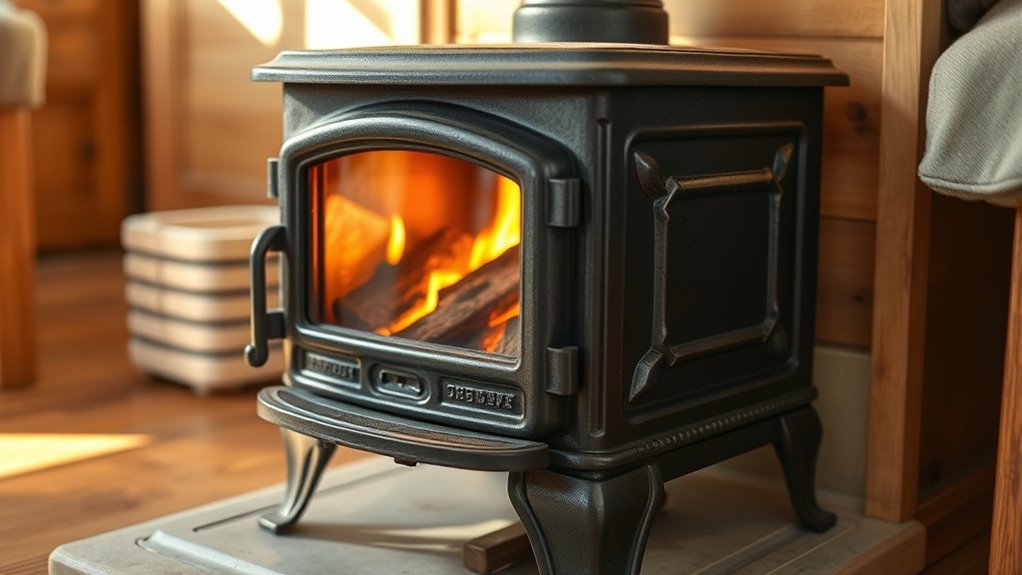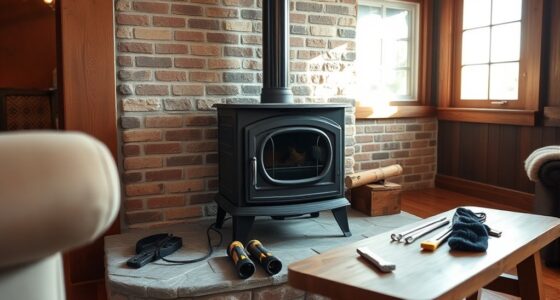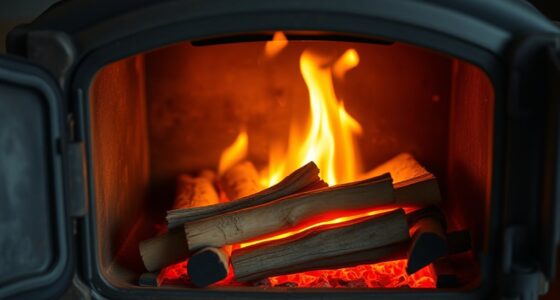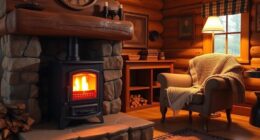Yes, a small wood stove can effectively heat your tiny home or RV if you choose the right model, properly install it, and perform regular maintenance. Its compact size makes it ideal for small spaces, providing consistent warmth and enhancing comfort. However, safety measures like keeping clearances and proper venting are essential for safe operation. To learn how to optimize its benefits and ensure safety, continue exploring important tips and guidelines.
Key Takeaways
- Small wood stoves are designed to efficiently heat compact spaces like tiny homes and RVs.
- Proper installation and venting are essential for safe and effective use in small areas.
- They provide consistent, cozy warmth suitable as primary or supplemental heating sources.
- Adequate clearance, fire safety measures, and regular maintenance ensure safe operation.
- Choosing models with safety features enhances efficiency and minimizes fire risks in confined spaces.
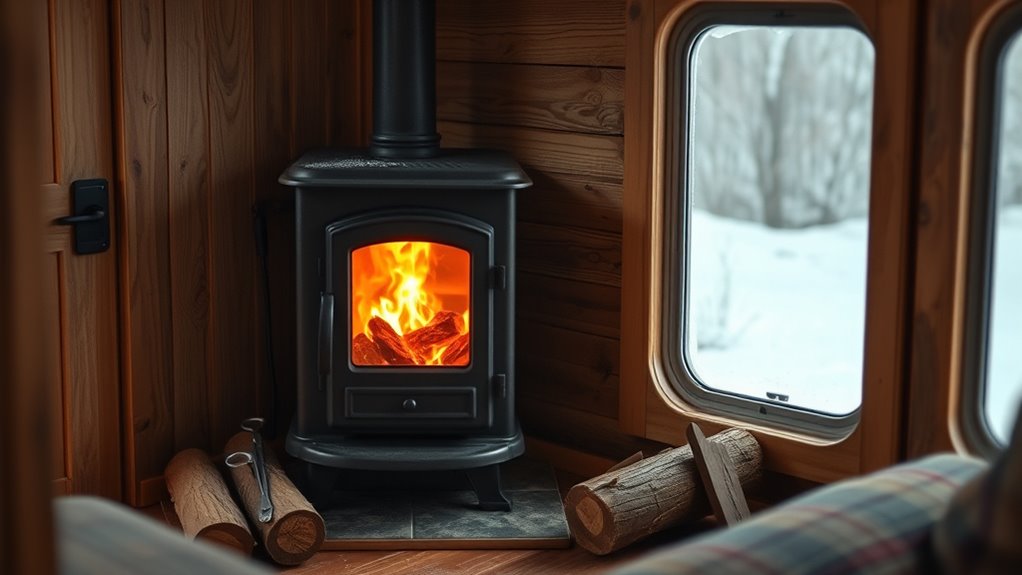
If you’re heating a tiny home or RV, a small wood stove can be an efficient and cozy solution. These stoves are compact, easy to operate, and capable of providing consistent warmth in small spaces. However, before installing one, it’s imperative to prioritize fire safety and carefully follow installation guidelines. Proper setup not only ensures the stove functions effectively but also keeps you and your property safe.
First, understanding fire safety is essential. Wood stoves generate high heat, so you need to make sure they’re installed at a safe distance from combustible materials like walls, furniture, and curtains. Use non-combustible materials such as metal or fire-resistant boards behind and around the stove. Keep a clear space around the stove—at least 36 inches is recommended—so that nothing can accidentally catch fire. Additionally, installing a smoke detector and carbon monoxide alarm nearby adds an extra layer of safety, alerting you promptly if anything goes wrong. Regularly inspecting your stove and venting system helps maintain safety and efficiency over time.
Ensure safe distances from combustibles and install detectors for optimal safety.
When it comes to installation guidelines, meticulous planning is critical. You should always follow the manufacturer’s instructions, as each stove model may have specific requirements. Usually, you’ll need a solid, level base made of non-combustible material like concrete or brick to support the weight of the stove. Venting is another key aspect; a properly installed chimney or stovepipe must be secure, insulated, and lead outside to prevent smoke or dangerous gases from accumulating inside your tiny home or RV. Make sure the venting system has the appropriate clearance from combustible materials and is properly sealed to prevent leaks.
Ventilation is essential not only for safety but also for efficiency. Adequate airflow ensures the stove burns efficiently and reduces creosote buildup, which can pose fire hazards. Regularly inspect the chimney and stovepipe for blockages or soot accumulation. Also, avoid overloading the stove with wood, as this can cause overheating and increase the risk of fire. Incorporating proper ventilation and airflow techniques can significantly improve stove performance and safety. Additionally, choosing a stove with efficiency features can help maximize heat output while minimizing fuel consumption. To further enhance safety, consider adding fire-resistant barriers around the stove area to protect surrounding surfaces from heat.
In an RV or tiny home, space constraints make it indispensable to choose a stove that fits well within your layout. Many models are designed specifically for small spaces, featuring safety features like cool-touch handles and automatic shut-off systems. Remember, proper installation and ongoing maintenance are your best defenses against fire hazards. By respecting fire safety principles and following installation guidelines, you’ll enjoy the warmth and ambiance of your small wood stove without compromising safety or efficiency.
Frequently Asked Questions
What Safety Precautions Should I Take With a Small Wood Stove?
You should prioritize fire safety by installing your stove properly, following all manufacturer instructions and local codes. Keep a fire extinguisher nearby and ensure good ventilation. During stove installation, use a heat-resistant pad underneath and maintain a safe clearance from combustible materials. Regularly inspect your stove and chimney for creosote buildup or damage. By taking these precautions, you’ll enjoy warmth securely and reduce the risk of accidents.
How Much Space Is Needed Around the Stove for Ventilation?
Sure, because nothing says cozy like a smoky fire in your tiny paradise! You should keep at least 36 inches of ventilation clearance around your stove for safe stove spacing. This ensures proper airflow and reduces fire risk. Remember, skimping on stove spacing isn’t just risky, it’s downright reckless. Prioritize safety by maintaining adequate ventilation clearance, and enjoy your warm, snug tiny home without turning it into a chimney.
Can a Small Wood Stove Be Used During Power Outages?
Yes, you can use a small wood stove during power outages as an alternative heating method. Just make certain you follow wood stove safety guidelines, like proper ventilation and keeping flammable materials away. Always operate the stove in a well-ventilated space and have a carbon monoxide detector nearby. This way, you stay warm safely, even when the power’s out, making your tiny home or RV cozy and secure.
What Are the Maintenance Requirements for a Tiny Home Stove?
You need to regularly maintain your tiny home stove to keep it running efficiently. Check the fuel efficiency by choosing dry, seasoned wood, which burns cleaner and longer. Make sure to clean the chimney at least once a year to prevent creosote buildup, reducing fire risk and improving airflow. Additionally, inspect seals and gaskets periodically, ensuring safe operation and ideal heat output during cold months.
Are There Eco-Friendly Options for Small Wood Stoves?
Did you know that eco-friendly small wood stoves can reduce emissions by up to 70%? Yes, there are biomass alternatives and renewable fuels available that make your heating more sustainable. These options burn cleaner and produce fewer pollutants, helping you lower your carbon footprint. By choosing eco-friendly small wood stoves, you support renewable energy efforts and enjoy efficient heating that’s better for the environment.
Conclusion
In conclusion, a small wood stove can indeed heat your tiny home or RV effectively, providing cozy warmth even in the coldest weather. Just remember to follow safety guidelines and guarantee proper ventilation. While some might think it’s straight out of a Victorian novel, using a wood stove today offers a charming and reliable heating option. So, if you’re seeking a snug, rustic vibe, a small wood stove might just be your perfect match.

